Student Blog
Caroline

How hard is graduate school? ⟩
December 8, 2017, by Caroline
Prospective students frequently ask: how hard is graduate school? What might I be getting myself into? Will I ever do anything other than study? Let’s jump in!
How many days per week do you have class?
The Entry-Level Masters program is full-time; I take up to 18 credit hours per semester, which means I spend 18 hours in the classroom each week. This is usually broken into 6 hours of class, 3 days per week. Most of the time, classes are 9AM-12PM and 1PM-4PM, with a break at noon for lunch. Professors also give us a break in the middle of class to get up, move around, and snack! Additionally, I have Level I fieldwork experiences one day per week. Total, that’s 4 full days per week devoted to schoolwork, with weekends and one weekday off.
For more information, check out our course sequence.
What are graduate school classes like?
Each course is organized differently, but I’ll describe some of the common course designs.
Some courses (OT 538: Current Issues in Practice: Adulthood and Aging or OT 534: Health Promotion and Wellness, for example) are held in a large lecture hall that fits my whole class. These courses are primarily lecture, with some group work mixed in. Often, we will have guest lecturers come in to speak about a particular area of expertise or lived experience, which is cool!
Other thread courses (OT 523: Communication Skills for Effective Practice or OT 518: Quantitative Research for Evidence-Based Practice, for example) are smaller, just with my cohort of about 45 students. These courses include time for lecture and instruction, but also time to work on group activities and semester-long projects.
The 3 practice immersion courses (OT 501: Adult Physical Rehabilitation, OT 502: Mental Health, and OT 503: Pediatrics) are unique in a few ways. Instead of meeting only once per week like the other courses, these courses meet 3 times per week, each time for 3 hours. Twice per week I have lecture for my immersion course with my cohort of about 45 students. I also have lab once per week, which is with just half of my cohort – about 22 students. The immersion courses utilize principles of team-based learning. Instead of sitting in a classroom listening to a lecture for 3 hours straight, a lot of time spent in class is active and interactive. I’m frequently working in groups and teams of classmates on case studies, application activities, discussions, and hands-on learning experiences. This means that my professors expect me to come to class having read the assigned textbook and articles, ready to ask questions about them and then apply what I’ve learned.
For more information, check out our course descriptions.
What about homework, projects, and exams?
Similarly, each course syllabus is structured differently. All courses require textbook and/or article readings each week. Some courses have weekly quizzes on the readings (sometimes taken individually, often taken with a group). Many courses have a midterm exam and a final exam (sometimes cumulative, sometimes not). A few of my classes have had large semester-long group projects, research papers, or presentations. Participation and professionalism are always a component of my final grades, so I always make sure I am in class, prepared for class, and ready to participate!
So . . . how hard is it all?
I’ve truly found graduate school to be quite manageable. When I think about what’s expected of me in the program, 3 things stand out:
- Support
First, the program and the people in it are incredibly supportive; it’s far from a competitive environment. I share notes with my classmates and divide up study guide preparations with friends to make exam prep more manageable. I want my friends and classmates to be the best OTs they can be, so why wouldn’t we help each other out? Faculty and staff have been so relatable and understanding and always make themselves available to answer questions! They understand everything we have on our plates, and they never give us more than we can handle. - Knowing Myself
Second, it’s important to know yourself and how you work. I’ve learned that I work best under pressure. I like to juggle a lot of different things and stay busy, so when I do have time set aside to get work done, I know that I will be productive and efficient. I also very much value balance, and know that I won’t feel happy if I spend all of my time on schoolwork. I have a “No Homework Saturday” rule that I have not broken throughout my entire graduate school experience (I’m quite proud of this). I reserve Saturdays to get out of my apartment, explore LA, and spend time with friends. “No Homework Saturday” has become a mantra among my friends in the program, serving as a reminder that it’s OK to take a break even when the work is piling up. Everyone is different, however, so it’s important to figure out your style so that you can manage your time and responsibilities! - Passion for what I’m learning
Third, and finally, I’m in this program because I am pursuing my passion to become an Occupational Therapist. The curriculum and expectations of me in the program are designed to prepare me to be the best OT than I can be. As a result, I see the value in the courses I take, the assignments I’m turning in, and the pages of reading I complete. The time I spend on schoolwork is not time wasted. Sure, I sometimes have long hours studying, but I feel motivated to study, and not only because I want to do well in school or pass my national boards exam. I also understand that what I’m learning now is information I will continue to be tested on when practicing in the real world for the duration of my career as an OT. Whenever I’m feeling overwhelmed by school, I try and zoom out to see the big picture! It’s hard work, but will definitely be worth it!
In short, graduate school is challenging, but it should be! I’m learning so many new skills, theories, and ways of thinking that I constantly feel like my mind is stretching, but not to the point of feeling overwhelmed. It’s the right amount of challenge, and I always have time for my “No Homework Saturday.” 😊
⋯

The 4 Thanksgiving Fs: Food, Friends, Football, and Family ⟩
November 21, 2017, by Caroline
It might not be Thanksgiving quite yet, but the Thanksgiving spirit is definitely in the air (can you tell from Bryan and Ali’s posts?). Well, you lucky readers, here comes one more Thanksgiving appreciation blog!
This past weekend was filled with three of my favorite Thanksgiving occupations: food, friends, and football.
On Friday night, I journeyed out to a classmate’s house a couple hours outside LA for an early Thanksgiving with friends. It was truly one of the highlights of my semester. Let me tell you — the air was so fresh and I could see stars in the sky! I’ve definitely gotten used to big city life (and all of its perks) but it was a breath of (literal) fresh air to get out of the city for a night! We had a huge buffet of food, a fire pit, and so many laughs. It was a great chance to get together with friends who aren’t in my cohort and catch up!
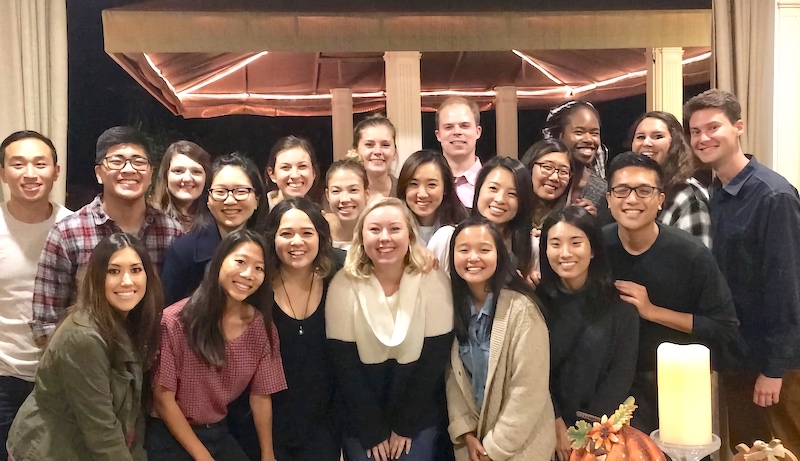
A food- and friendship-filled early Thanksgiving celebration with wonderful friends from the program.
On Saturday, I went to the USC vs. UCLA football game. Our OT programs were actually being recognized at the game, so a big group of us got to go onto the field for a photo op before warm ups. Definitely a different view than the one I’m used to from the student section! We were also featured on the screen during the game — how cool right?! After the photo op, I went to the OT and Physical Therapy tailgate (gotta love the interprofessional mixing!) before heading to the game (which we won!!). Go Trojans!

Here’s the picture of our whole group out on the field. Check out those V’s for victory!
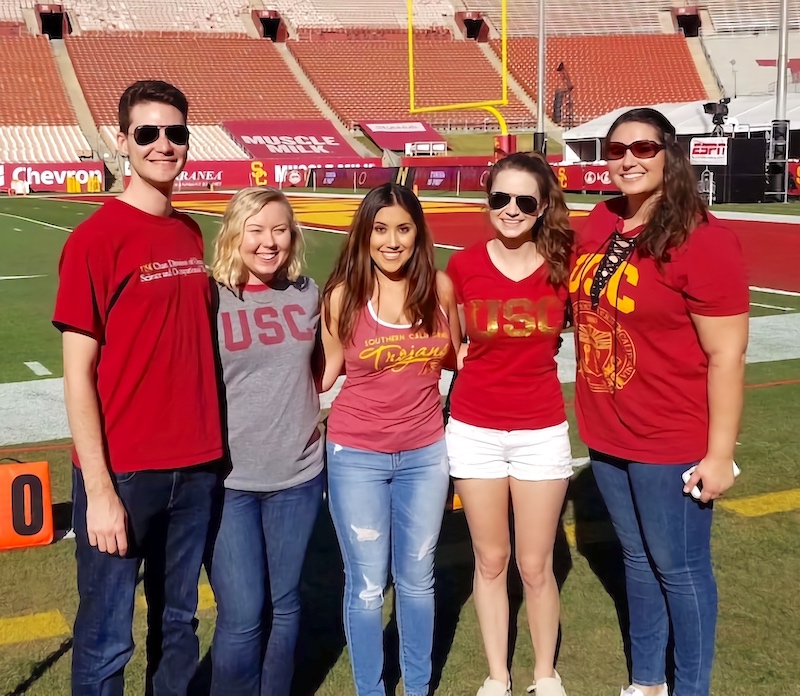
Another photo from our experience on the field!
Food, Friends, and Football — it was definitely a fun weekend. “And the last F?” my detail-oriented readers might ask. Family time is coming soon! In fact, I’m writing this from none other than LAX airport waiting to board my flight back home to North Carolina. As I was packing my sweaters and winter clothes and gearing up for colder weather back on the East Coast, I jokingly texted my mom that I’d rather stay in LA for 90 degree Thanksgiving weather. She knew exactly what would convince me to come home — pictures of my dogs that are (almost) as excited for me to come home as my human family. Guess I could add one more F to my list of Thanksgiving words: fluffy pups. Photos of the pups included to increase the cuteness factor of this blog post:
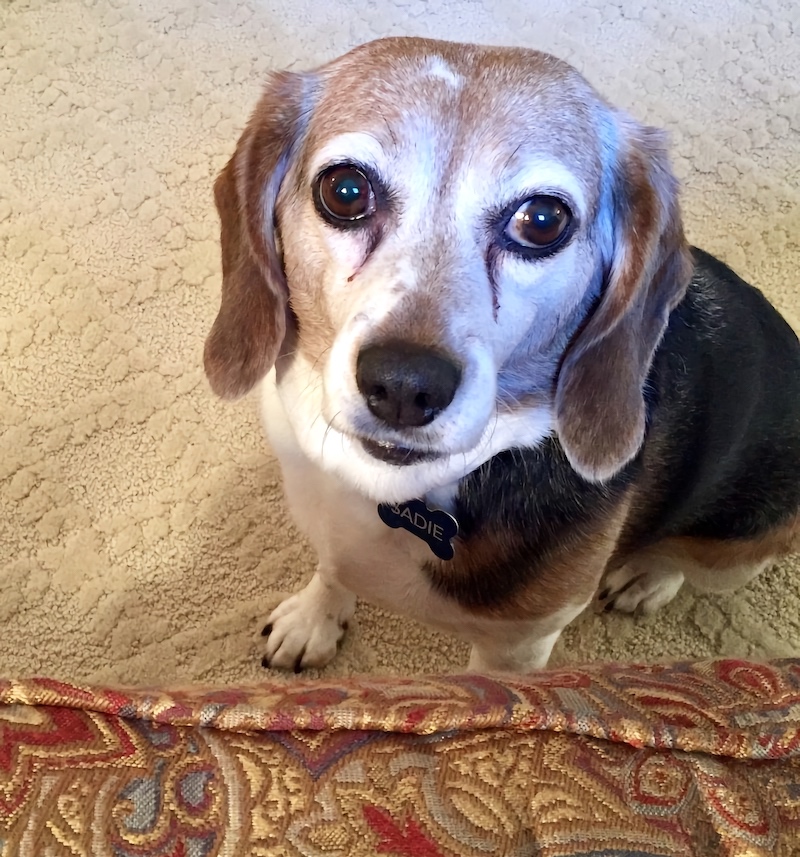
Meet Sadie, who is very excited to lounge with me on the couch. Look at those needy eyes!
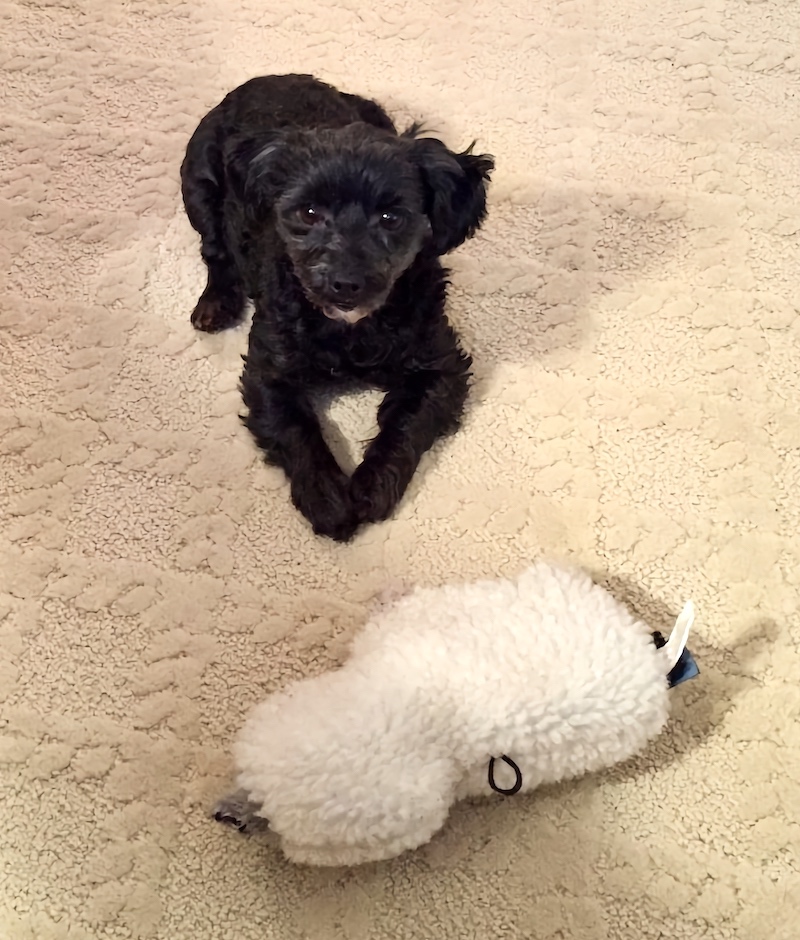
Meet Gracie, who is excited to have another human at home to play with her!
Looking forward to a few days off from school before heading back for the last week of classes and final exams. Happy Thanksgiving to all!
⋯

Telling People About OT: One of my Favorite Occupations! ⟩
November 9, 2017, by Caroline
I must apologize for my long delay in blogging, but I promise I have a good excuse! My favorite part of being a Student Ambassador is speaking with prospective students about Occupational Therapy and our programs at USC. These past few weeks, I’ve been all over the greater LA area presenting at various universities and speaking with prospective students about OT and our programs. When someone asks me about OT, my immediate response is “do you have 2 minutes or 2 hours?” OT is one of my favorite topics of conversation, so the fact that I get to spread the word about OT as my job is simply the best! Believe it or not, when I was applying to OT programs my senior year of college, I didn’t know a single other person interested in or applying to OT. I managed to navigate the process by myself, but I’ve had so much fun visiting Pre-OT clubs and other student organizations at various universities and connecting with students who are as passionate about OT as I am!
In addition to traveling around to different universities to give presentations, I’ve also started giving virtual presentations to groups and universities that are a little farther away geographically, but are interested in learning more about OT at USC. I was able to connect with and present to students from my undergrad in North Carolina (Wake Forest University — Go Deacs!) which was particularly exciting for me! Technology is the best! If you’re reading this and would like to set up a virtual presentation for a group of students at your college or university, feel free to reach out to me at .(JavaScript must be enabled to view this email address) — I would love to make that happen!
We’ve also started doing Admissions Information Sessions virtually as well. We tend to hold about two Information Sessions per month on our campus here in LA, but we want students to be able to get the same information even if they can’t travel out here. I know I would have appreciated that when I was a prospective student! We already have a Virtual Admissions Information Session scheduled for March 29, 2018, so mark your calendars and check out our website for information on how to register.
As always, feel free to reach out to any of the Student Ambassadors by email or leave a comment if you have any specific questions about our experiences or want to follow-up about something we talked about in our blog!
⋯

Take a Peek at Pediatrics! ⟩
October 11, 2017, by Caroline
Whenever I give prospective students a tour of our facilities and classrooms during Information Sessions, the Pediatrics classroom tends to get a lot of “oohs” and “aahs.” Rightfully so! Half of the classroom is filled with colorful things to jump on, climb on, swing on, and crash into, which certainly looks a lot more fun than most classrooms I’ve seen! OTs who work in Pediatrics definitely try to make everything they do with their pediatric clients fun and engaging, and the same can be said for our Pediatrics professors. I spend 9 hours each week in my Pediatrics class, but it’s so much more than a lecture with my professors talking at me the whole time! The course integrates team application activities, case studies, and a lot of exploring and trying out different assessment and intervention approaches.
I’ve already told you about my Fieldwork experience in a school-based setting, but now let me give you a peek into my Pediatrics course!
I don’t have pictures for privacy reasons, but we had the opportunity to interact with children and with parents when learning about doing parent interviews and conducting standardized assessments. As a class, we got to practice interviewing a parent of a child who receives OT services, and he was able to give us feedback about how we did. Additionally, professors bring their children into the lab, so we can look at their primitive reflexes and learn about how to conduct standardized assessments. We learned that it’s a lot harder than it looks, but that it becomes easier as you get more familiar with the assessments.

Different snacks used for a grasp analysis activity
When learning about different grasps (how we manipulate our fingers and hands to grab objects) our professors brought in some snacks. Grabbing yummy snacks and bringing them to our mouths was definitely an inherently motivating and fun way to review the various types of grasps. I realized that we grab a sunflower seed differently than we grab something bigger like a cheese-it, which is something I hadn’t thought about before. Next time you’re eating a snack, pay attention to how you pick up your food to eat it!
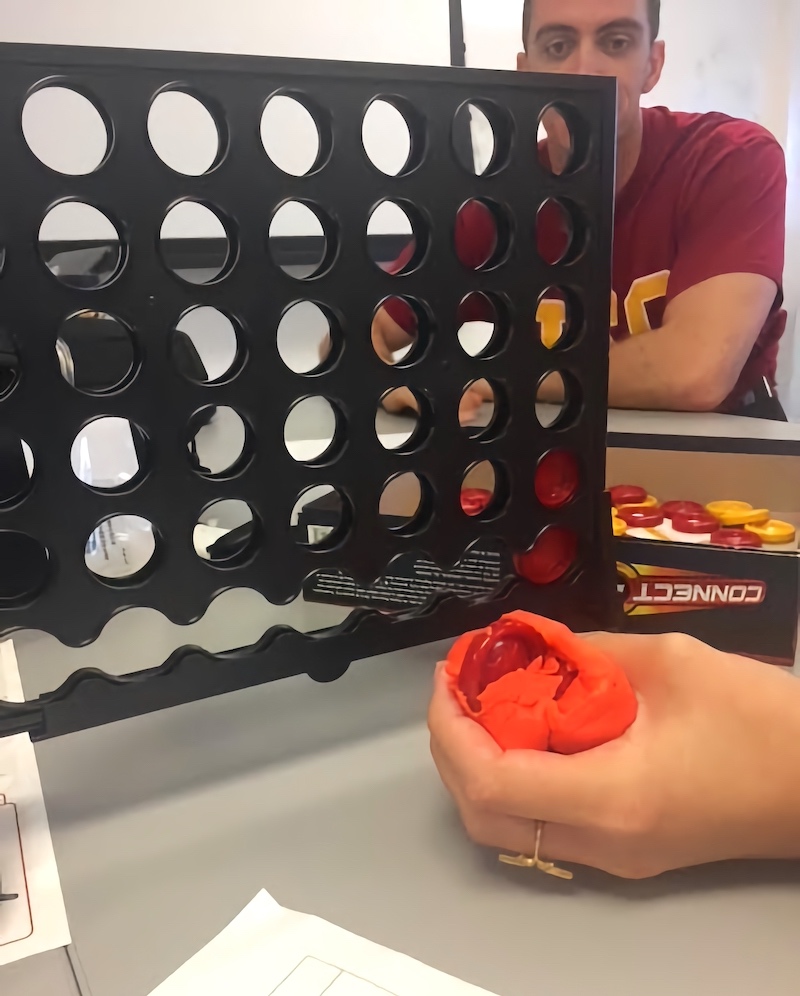
We planned a treatment using Connect 4 and Play-Doh
When practicing planning treatments that address different fine motor skills, our professors put random objects on the table and told us to come up with a fine motor skill treatment using those objects on the spot! My group had play-doh and Connect 4, so we decided to hide the Connect 4 pieces inside the play-doh. That way, by manipulating the play-doh, the child is building up strength in the small muscles in their hands. Then, we can address grasp when looking at how they hold the Connect 4 pieces. We also came up with ways to change the activity to make it more challenging and less challenging. It may look simple, but there’s a lot of thought behind each pediatric treatment!
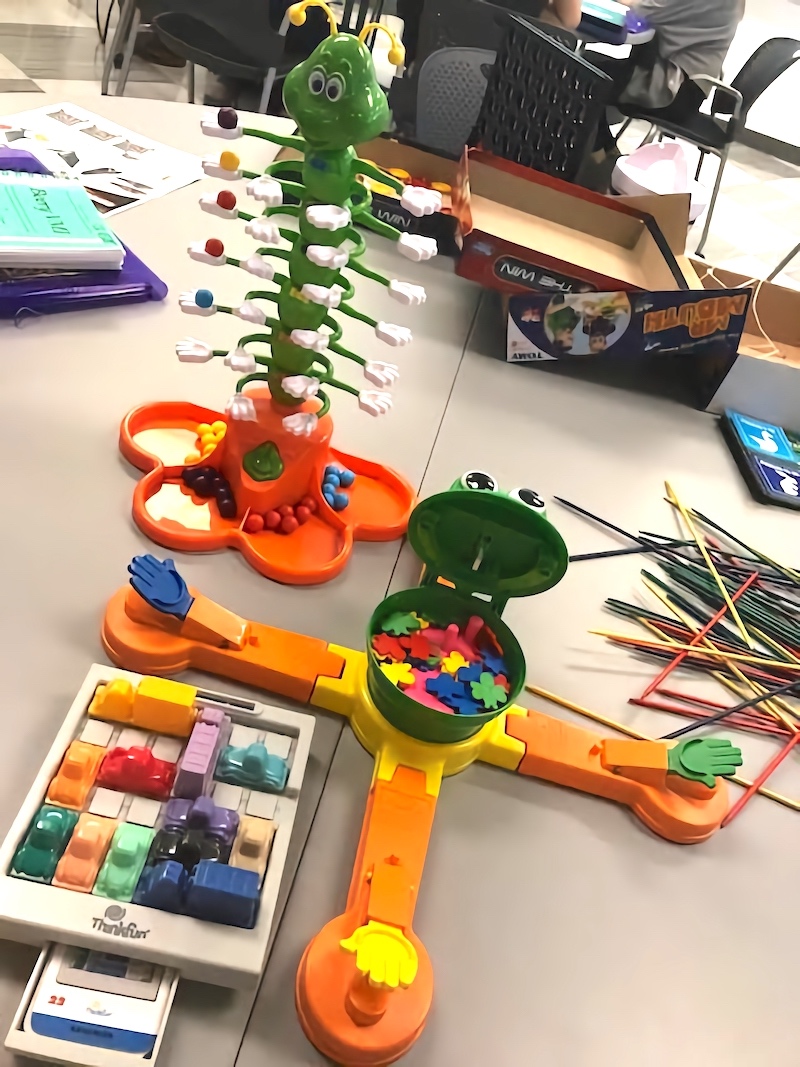
Lots of different games can be used in OT!
When learning about visuomotor integration (how our vision and perceptual skills work with our fine motor skills to help us interact with our environment efficiently), we got to try out a lot of different games and think about how they could be used in treatment. One of my professors said something that really stuck with me: generally, the children that OTs work with may have a hard time playing a game exactly as it is designed or following the exact direction. This means that it’s the OT’s job to adapt the game and make it the right challenge for each child, allowing them to work on certain skills, but feel successful and have fun at the same time. OT treatment with children can often look like play, but there is a lot of work going on at the same time!

Some of the materials used in the Handwriting Without Tears Program. I practiced using the wooden blocks to put together a few letters!
When learning about handwriting interventions, we got to explore the Handwriting Without Tears program, which aims to do exactly what the name sounds like! For children who have a hard time learning to write or making their writing legible, working on handwriting in therapy could start to feel boring and like work, so a couple of OTs created the Handwriting Without Tears program to make handwriting intervention more dynamic and fun. Children can practice writing on an etch-a-sketch and chalkboards and can form letters with play doh and wooden blocks. This program uses a multisensory approach and has a lot of different options to make treatment fun and different. I’ve used this program used at my fieldwork site, and the kids definitely enjoy it!
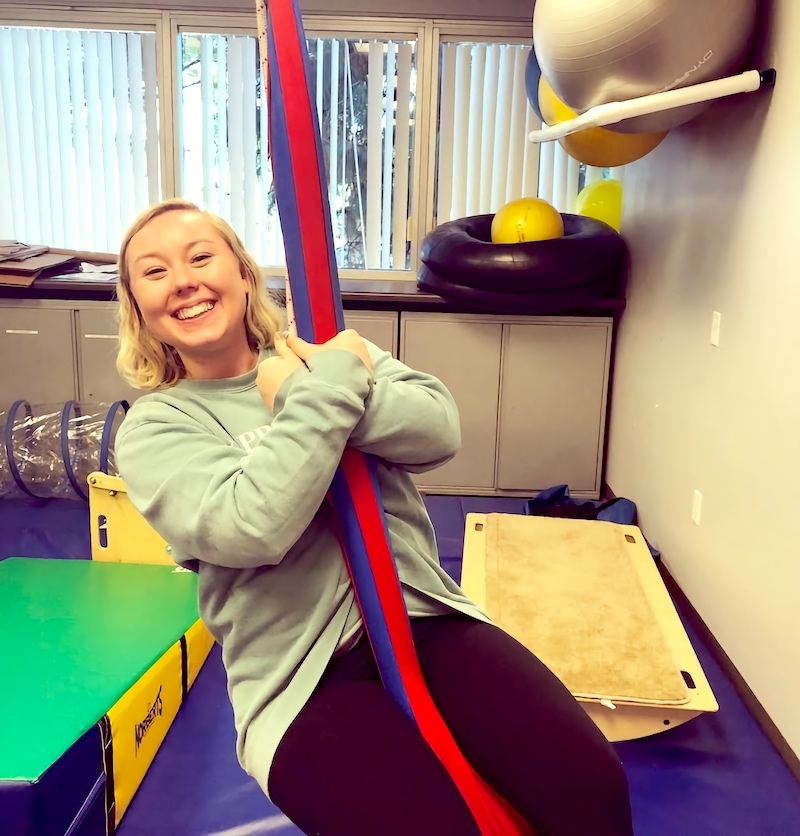
Getting a little vestibular input from one of the swings!
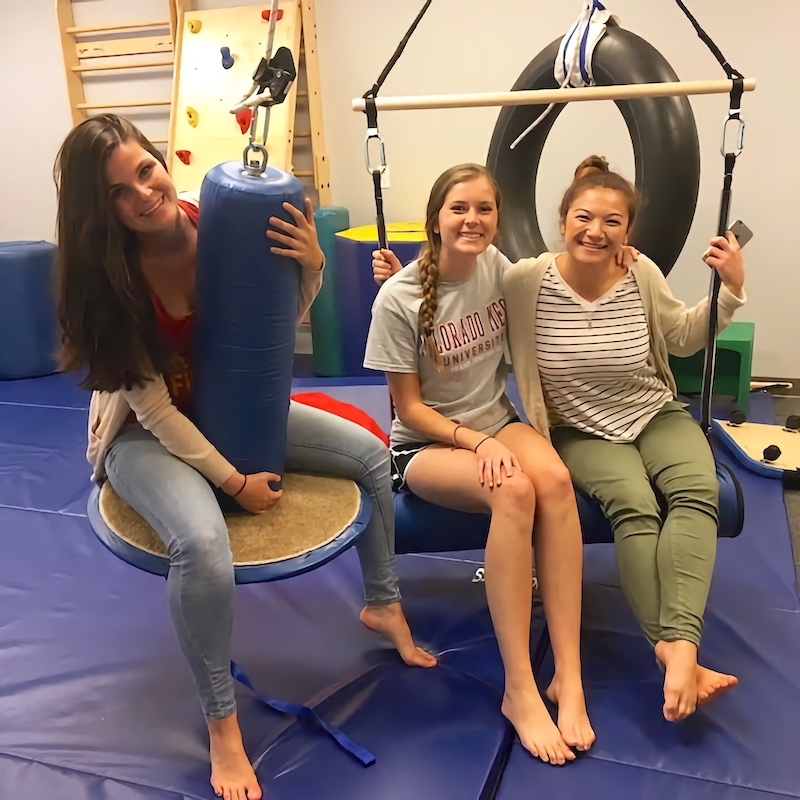
Check out some of my classmates on other swings!
Finally, last week we were learning about Sensory Integration theory and intervention, which was actually developed by A. Jean Ayres, a former OT faculty member here at USC! We learned all about our sensory systems, how they’re supposed to work, what it can look or feel like when they’re not working as they should, and what Sensory Integration can do to help. My professor reminded us that you should always try out an activity yourself before having a child do the activity in therapy, to ensure that it’s the right level of challenge and actually addresses what you want the intervention to address. So, we did exactly that! We explored the lab space and got on different swings and equipment to see what it feels like, how challenging they are, and how our bodies feels afterwards. It was such a fun day!
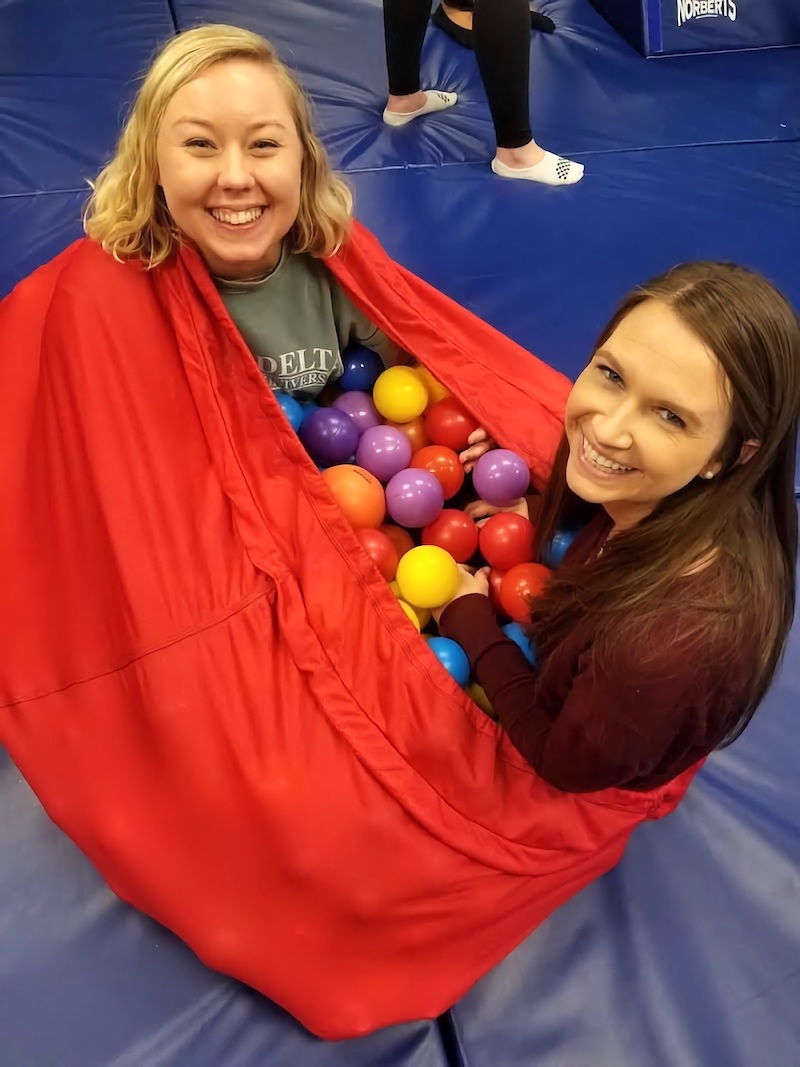
Just two peas in a pod getting some tactile input!
I’m so appreciative of all of the time and effort my professors put in when planning the course and the time spent in the classroom. I’m definitely a learn-by-doing kind of person, so I love when I get to be hands-on in the classroom. My pediatrics midterm is coming up next week, so I’m definitely starting to reflect on everything I’ve learned this first half of the semester. Wish me luck!
⋯

Let’s Talk Fieldwork — Part II: School-Based Pediatrics ⟩
September 28, 2017, by Caroline
In my previous blog post I explained how Level I and Level II Fieldwork experiences work in our program at USC, and shared about my previous Fieldwork placements. As promised, this blog is devoted to my current Level I Fieldwork experience!
I am in the Pediatrics Immersion, which means that my Fieldwork is also in a pediatric OT setting. I’ve been placed in a local school district, so I get to see school-based pediatrics. I was really excited when I first got my placement, because I had observed pediatrics before, but not in a school-based setting, so this would be a new experience for me! I spend most of my time at an elementary school, but my Clinical Instructor (CI) and I also go over to a local high school to treat some students there as well.
I just had my 3rd day at my Fieldwork site, and I have already gotten to observe and assist with so many different things! Because my CI has a pretty consistent schedule, I get to see the same kids each week. This allows me to see growth and change in the clients, helps them to become more comfortable with me, and gives me the opportunity to begin planning and leading treatments with them as I become more familiar with them, their goals, and their interests.
The elementary school where I’m placed has a pretty unique setup, because my CI has an awesome OT clinic room all to himself — mats, obstacle course, swings, and all! With all of the materials and resources, there are so many possibilities for treatment and intervention, which is so exciting!
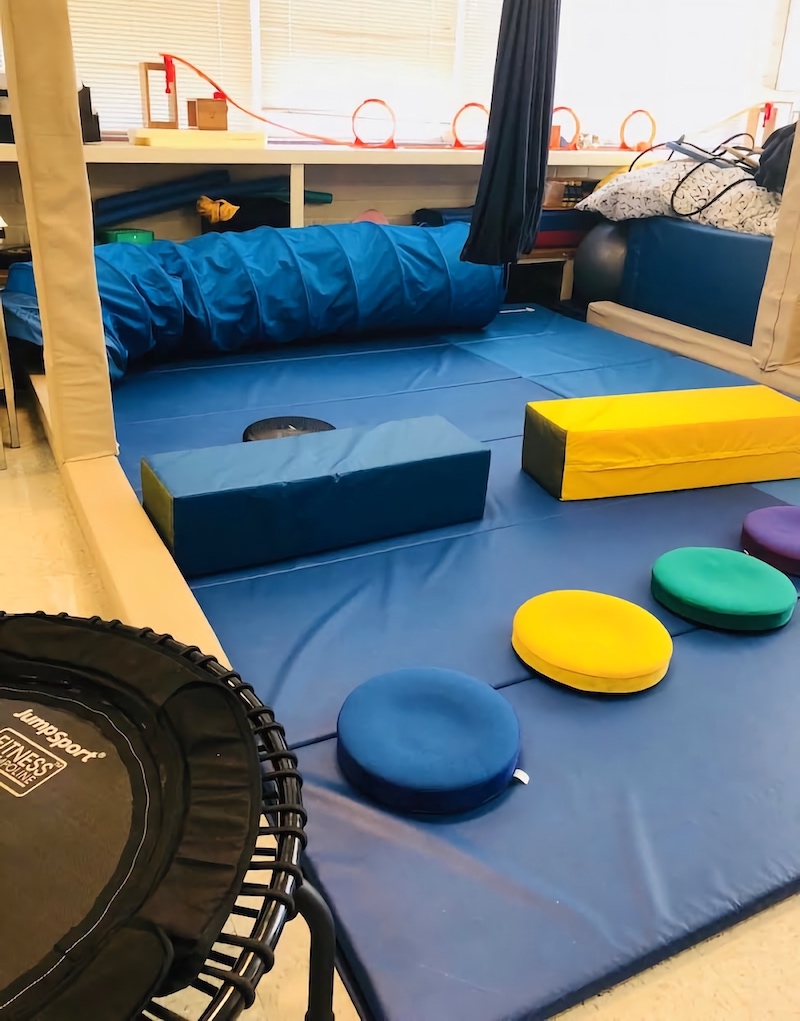
Here you can see the OT clinic space at the elementary school. Lots of space for obstacle courses, movement, and fun!
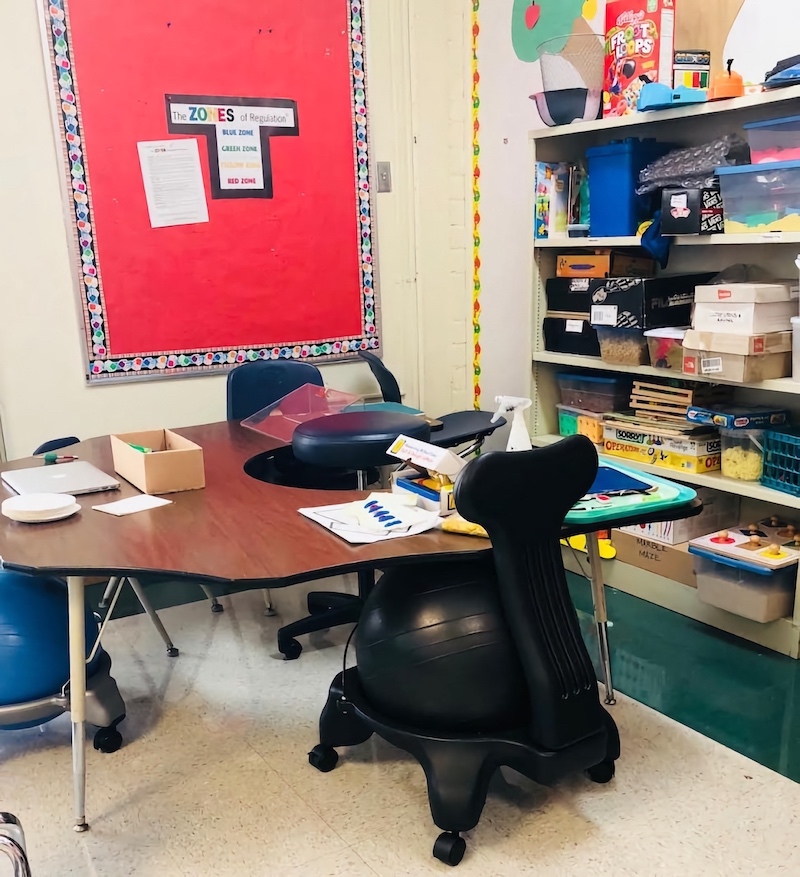
The OT clinic also has a great table-top setup to work on handwriting and other fine motor skills!
A Typical Morning at my School-Based Fieldwork Site
8:15 — Arrive, plan for the clients that day, prepare any materials needed.
9:00-9:30 — Pull a client out of class for an individual OT session. We used play-doh to work on hand strength, bilateral coordination (using both hands at the same time in a controlled manner), and pre-writing (by using the play-doh to spell out the client’s name).
9:30-10:00 — Pull another client out of class for an individual OT session. We used a three-step obstacle course in the clinic room to work on gross motor control (coordinating the large parts of your body, like legs, arms, and trunk to move) and task sequencing (progressing smoothly through a multi-step activity).
10:00-10:30 — Time for documentation and planning.
10:30-11:30 — We run an OT and Speech group with one of the Special Ed classrooms. We led the students through a song with choreographed dance moves (jumping, running in place, spinning) and then completed a craft activity based on the song that worked on fine motor skills (activities that require the use of the smaller body parts, such as the hands and fingers) like handwriting, cutting, coloring, tearing paper, and squeezing glue.
11:30-12:00 — Time for documentation and planning.
12:00-12:30 — Lunchtime (in the teacher’s lounge! It’s definitely not as mysterious as my elementary-school aged self thought it was 😊 ).
The mornings are pretty consistent, but the afternoons have a little bit more variability. Sometimes, we have meetings with parents and the rest of the team at school (Speech Therapists, Teachers, Psychologists, etc.) to address concerns or for an annual Individualized Education Program (IEP) meeting. At these meetings, it’s really cool to see the inter-disciplinary team working together to best support the individual child in the school environment. Other afternoons, we’ll go over to the nearby high school and work with some of the clients over there. I’ve enjoyed getting to see what school-based OT looks like for elementary-school aged children compared to high school students.
I’ve only had 3 days of Fieldwork, but I’m seeing individual clinic sessions with elementary and high-school aged students, group sessions, IEP and parent meetings, and more! My CI is also very open to me jumping in, taking charge, and planning and implementing some sessions with the kids. As I continue to learn more in my pediatrics class and am exposed to more at Fieldwork, I expect I’ll get more and more comfortable taking on more responsibility at Fieldwork!
My full week of fieldwork is coming up in a couple of weeks, so I’m looking forward to seeing even more clients! If you’ve observed OT in a school-based setting or have any questions about my experience, leave a comment below!
⋯





